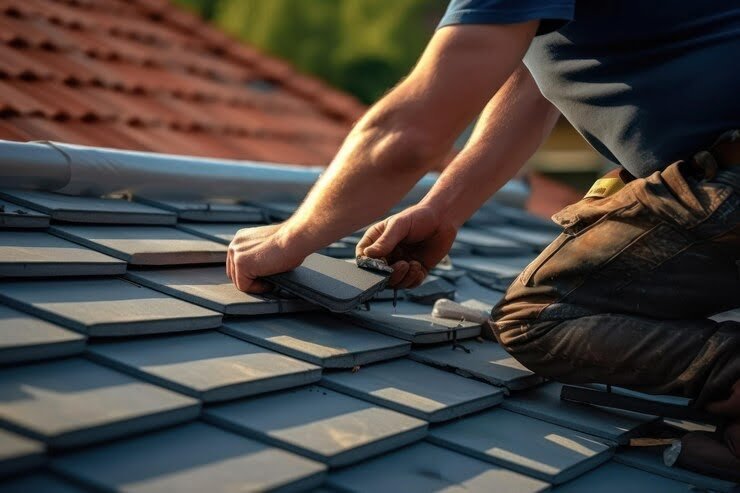Flashing is an integral yet often overlooked component of roofing systems. Improper installation or failure of flashing can lead to serious leaks, moisture damage, and costly repairs. This article will provide a detailed overview of roof flashing, its proper installation, and maintenance.
Roof flashing is a sheet metal or other material installed at joints and angles to prevent water infiltration. Flashing directs water away from vulnerable areas where the roof decking meets walls, dormers, chimneys, vent pipes, and other roof projections. When installed correctly, flashing creates an impermeable barrier that protects the structure from moisture damage.
Proper roof flashing installation is essential for leak prevention, especially around chimneys, skylights, dormers, valleys, and changes in roof planes. Improper flashing work can negate even the highest quality roofing materials. Flashing serves as the first line of defense in keeping water out of a building.
This comprehensive guide will cover the following topics:
- The different types and installation of roof flashing
- Common mistakes in flashing work
- Building codes and best practices
- A step-by-step flashing installation guide
- The role of flashing in various roof systems
- Maintenance and repairs for roof flashing
Understanding flashing helps enhance roof performance and longevity. So whether you’re a homeowner, roofer, or builder, this resource can improve your flashing knowledge and installation skills.
The Role of Roof Flashing
Before delving into proper installation, it’s important to understand why flashing is fundamental to roof performance.
How Flashing Prevents Leaks
Flashing creates a waterproof connection between the roof planes and protrusions that penetrate the roof deck. It deflects water away and covers any gaps or cracks.
Flashing is installed at roof to wall intersections, where the roof decking meets a vertical wall. Step flashing applied along the sides of chimneys, dormers, and skylights routes water around these vertical elements. Valleys use flashing to carry water away from the seam where two roof planes join.
By covering vulnerable spots and managing moisture flow, proper flashing prevents water seepage into cracks. It provides the first line of defense against wind-driven rain. Correctly integrated flashing can greatly extend the lifespan of the roof.
Types of Roof Flashing
There are several types of flashing designed for different roof components:
- Step flashing – Used along walls, chimneys, dormers. Pieces overlap in a stair-step pattern up the roof.
- Counterflashing – Applied over step flashing edges for extra protection. Usually metal or aluminum.
- Valley flashing – Runs along the seam where two roof planes join in a valley.
- Pipe flashing – Used for sealing around pipe penetrations.
- Reglet flashing – Inserted into a reglet joint for mounting or sealing purposes.
- Rake flashing – Applied along roof edges or rake boards.
- Roll-top flashing – Rolled metal flashing for chimneys and penetrations.
Each flashing type serves a specific function. Correct installation requires using the right flashing in the appropriate areas.
Flashing Materials
Common flashing materials include:
- Galvanized steel – Economical option but prone to rust over time. Requires painting.
- Aluminum – Resistant to corrosion. More expensive but very durable.
- Copper – Naturally corrosion-resistant. Requires soldered joints. High cost.
- Lead – Historically popular but toxic if deteriorating. Being phased out.
- Rubberized asphalt – Flexible synthetic material. Used for some step flashing.
- PVC or TPO – Durable plastics often used for residential work.
- EPDM – Synthetic rubber sheeting, sometimes reinforced with metal.
Material choice depends on budget, local building codes, roof type, and longevity desired. Copper, lead-coated copper, aluminum, and stainless steel offer the greatest durability.
Common Mistakes in Flashing Installation
Incorrect flashing work compromises the water-tightness of the roof system. Some common errors include:
Inadequate Overlap
Flashing pieces must overlap by 4-6 inches minimum. Insufficient overlap leaves gaps for water intrusion.
Lack of Step Flashing
Skipping step flashing along walls or roof protrusions risks major leaks. Each shingle step should be individually flashed.
Poor Sealing
All seams and nails must be properly sealed with adhesive, sealant, or solder. Gaps get exploited by wind-driven rain.
Flashing Not Extending Past Shingles
Flashing should lie on top of shingles below and under those above. This covers any entry points.
Improper Use of Materials
Each flashing type serves a purpose (e.g. valley flashing is not interchangeable with step flashing).
Lack of Counterflashing
Extra metal counterflashing provides redundancy if the base flashing fails. Omitting it removes a layer of protection.
Rushing the Job
Sloppy, rushed work often leads to flashing errors. Proper installation is exacting and needs patience.
These common mistakes permit leaks, especially during extreme weather. The remedy often involves complete flashing replacement at great expense. It is much cheaper to install flashing correctly the first time.
Unless you’re highly experienced, hire professional roofers for flashing work. Paying for skilled installation now prevents costly repairs later. One mistake can lead to moisture ruining the entire underlying structure.
Roofing Code and Standards for Flashing
Building codes and industry standards dictate minimum specifications for the proper installation of flashing. Familiarity with the regulations is mandatory for compliance.
Building Code Requirements
The International Building Code (IBC) and International Residential Code provide the model standards adopted by many states and municipalities. The codes specify:
- Materials permitted for flashing in different roof systems.
- Minimum dimensions for overlap and extension past roof edges.
- Usage of counterflashing over base flashing.
- Sealing requirements at projections and junctions.
- Flashing specifications for weather protection and drainage.
Roofing Standards
Industry groups like the Asphalt Roofing Manufacturers Association provide additional flashing standards focusing on roof system performance.
For example, ARMA’s Residential Asphalt Roofing Manual outlines best practices for flashing installation with asphalt shingles. The manual covers recommended materials, overlap distances, sealing methods, and compatibility with underlayments.
Following model building codes and roofing standards ensures the flashing work meets all structural, weatherproofing and durability objectives.
Step-by-Step Guide to Flashing Installation
With an understanding of flashing fundamentals, we can now drill down on the installation process.
Proper flashing takes meticulous attention to detail. Rushing leads to the errors mentioned earlier. Instead, set aside ample time for careful, methodical, and compliant installation.
Here are step-by-step instructions for flashing installation best practices:
Tools Needed
- Tin snips
- Hammer
- Utility knife
- Sealant gun
- Measuring tape
- Level
- Screwdriver
- Soldering iron and wire solder (for copper flashing)
Materials Required
- Self-adhesive butyl flashing tape
- Roofing cement/sealant
- Flashing material (metal, rubber, etc.)
- Fasteners – ring shank nails or flashing screws
- Plastic cement (for embedding shingle tabs)
Step Flashing Installation
Step flashing is used at roof-wall intersections, dormers, chimneys, and skylights. Each piece overlaps the one below it in a shingle pattern:
- Cut flashing pieces to size allowing a minimum 4” vertical leg and 4” overlap. The vertical leg will cover the roof accessory. The horizontal overlap joins pieces.
- Lift bottom roofing shingle tabs and apply sealant onto the roof deck. Ensure full contact between flashing and deck.
- Drive flashing fasteners through the overlap joints, 1” from the edge and spaced 8-12” apart. Embed heads in sealant.
- Apply plastic cement on top of the flashing. Press shingle tabs into cement to seal. Leave no nail heads exposed.
- Overlap next piece at least 4” over lower flashing. Fully embed horizontal leg in sealant before nailing.
6.Repeat steps to top of roof accessory. Apply sealant along vertical leg for waterproof seal.
- Install metal counterflashing overlapping top of base flashing. Secure into reglets if present.
Valley Flashing Installation
Valleys require an “open valley” style made of interwoven flashing:
- Cut two valley flashing pieces to length. Make starter piece wider to overhang edges 6-12”.
- Stitch nails along outer edges. Embed nail heads in sealant. Do not puncture central overlap.
- Lap subsequent flashing.
- Lap subsequent flashing pieces at least 8” over top of previous piece, keeping central overlap free of holes.
- Weave pieces together, crisscrossing sides over each other. Embed overlap joints in sealant.
- When nearing roof edge, cut final piece to fit. Extend end at least 12” onto roof deck past valley seam.
- Seal entire length of valley flashing overlap with roofing cement or butyl tape. Check for any gaps or cracks.
- Do not drive fasteners within 6” of valley centerline. Sealing must remain intact.
- Install shingles up to both sides of valley centerline. Trim to leave 1” gap at center for drainage.
Pipe Flashing Installation
Penetrations from plumbing vents, exhausts etc. need boot or collar flashing:
- Seal gap between pipe and roof deck with non-hardening sealant.
- Slide prefabricated boot flashing over pipe until base flange sits flush on roof deck.
- Apply sealant continuously between base flange and roof to prevent leaks.
- Secure metal collar around pipe above to boot top. Tighten collar with drawband.
- If needed, fill gap around pipe with fiberglass insulation for a snug fit.
- Apply roofing cement over flange nails and any seams on boot base.
- Install shingles over collar, overlapping in shingle fashion. Leave collar visible above shingles.
Always use the appropriate sized boot flashing for the pipe diameter. Correct sizing is vital to allow pipe movement while keeping water out.
Importance of Flashing Various Roof Systems
Flashing serves a universal function across all roof types. But the specific materials and installation techniques vary by the roofing system.
Asphalt Shingle Roofs
- Use self-sealing adhesive strips on flashing underside for easier lap joint sealing.
- Match flashing metal color to shingle coating to minimize visibility.
- Drive galvanized, ring shank nails high on shingle tabs into flashing seams. Embed heads in sealant.
- Alternate overlap direction and seal step flashing joints to prevent leaks.
Metal Roofs
- Solder flashing piece seams for optimal durability and water tightness.
- Use thicker gauge flashing metal to handle expansion/contraction stresses.
- Install reglets into mortar joints to secure counterflashing on bricks or stone.
- Account for greater expansion with wider overlaps (up to 8 inches).
Flat Roofs
- Incorporate tapered crickets behind chimneys, curbs, and walls to divert water.
- Coordinate roof slope and drainage to direct water away from flashing.
- Use adhesives compatible with single-ply membranes and modified bitumen systems.
- Install walkway pads to prevent foot traffic damage around flashing.
Tile Roofs
- Insert flashing under tiles with mortar for embedment rather than over them.
- Use copper, stainless steel, or lead flashing to match tile longevity.
- Set flashing into grooves saw-cut into wood substrate. Seal with flexible sealant.
- Leave expansion gaps under counterflashing edges interfacing with tiles.
Regardless of material, proper detailing and flashing integration prevents leaks. Planning application-specific details avoids issues down the road.
Maintenance and Repair of Roof Flashing
Flashing is intended to last the service life of the roof. But problems can develop over time that compromise its weather-tightness. Regular inspections, maintenance and timely repairs keep the flashing working properly.
Inspecting Flashing
Homeowners should periodically examine flashing for:
- Cracks, holes, separation at seams/joints
- Loose, damaged or missing shingles around flashing
- Signs of water entry like rust, staining or dripping
- Blocked drainage paths that could overload flashing
- Deteriorating, cracked, or missing sealant
- Gaps around penetrations allowing moisture intrusion
- Broken, loose, or missing fasteners
Address any deficiencies right away before leaks form. Prevention saves the hassle of interior repairs later.
Rust Treatment
For steel flashing, treat any rust formation promptly. Carefully wire brush rust to expose bare metal. Apply metal primer then matching roof sealant. For widespread corrosion, full flashing replacement may be required.
Resealing
Check roof cement and butyl sealant every few years, especially at seams prone to expansion/contraction. Reapply additional sealant before cracks develop.
Flashing Repair
If flashing damage is beyond sealant repair, flashing replacement may be necessary. This often occurs around chimneys, skylights and changed roof lines. A professional roofer can match existing material and install new flashing.
Roof Replacement
When re-roofing becomes necessary, the old flashing must also be replaced. Attempting to install new shingles over damaged flashing will compromise the entire roof system. Integrate roof and flashing replacement into your long-term budget.
With diligent maintenance, flashing should deliver decades of reliable protection against leaks. But periodic repairs will inevitably be needed, so early intervention prevents bigger expenses later.
Conclusion
As this guide has demonstrated, proper roof flashing installation and maintenance is vital for keeping water out of your home. Flashing acts as the first line of defense at vulnerable roof junctions and protrusions. Mastering flashing best practices protects against premature leaks and damage.
Key takeaways for homeowners and professionals include:
- Utilize the right flashing technique and material for each roofing situation.
- Meticulously seal seams, overlaps and edges during installation.
- Strictly follow roofing codes and flashing standards.
- Inspect flashing regularly and address defects immediately.
- Repair or replace compromised flashing before leaks form.
- Integrate flashing replacement into roofing system renovation.
While a reliable roofer can prove invaluable for flashing work, a working knowledge of the principles empowers you to protect your investment. Reference this guide anytime flashing installation or repairs become necessary. Your roof will thank you for it.








No Comment! Be the first one.